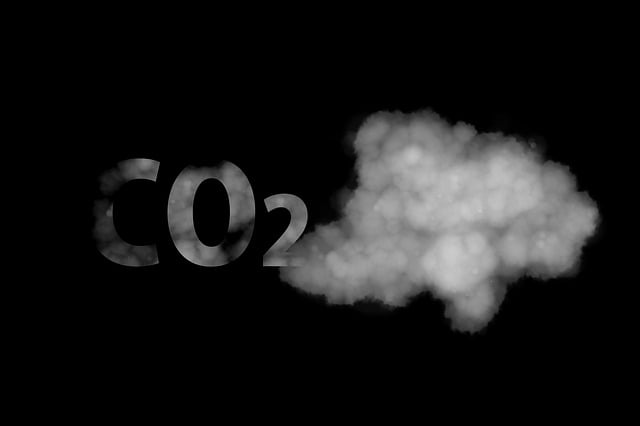


The hydrogenation of carbon dioxide allows the greenhouse gas to be transformed into products such as methane and methanol (image: Gerd Altmann/Pixabay)
Published on 05/26/2025
Agência FAPESP* – The goal of carbon dioxide (CO2) hydrogenation is to turn pollution into fuel. This process transforms CO2, one of the main greenhouse gases, into chemical products and renewable fuels. One important product is methanol, a versatile compound used in everything from plastics to fuels.
Other compounds can also be produced, such as methane, which can be injected directly into natural gas pipelines. Hydrocarbons with longer chains can be produced as well and can be used as gasoline or aviation fuel. This opens up the possibility of creating so-called e-fuels, which are sustainable alternatives to traditional fossil fuels.
An international consortium, including Liane Rossi, director of the Carbon Capture and Conversion Program (CCU) of the Research Center for Greenhouse Gas Innovation (RCGI) and professor at the Institute of Chemistry of the University of São Paulo (USP), in Brazil, presents an overview of the subject in an article published in the journal Science.
The RCGI is an Engineering Research Center (ERC) set up by FAPESP and Shell at the Engineering School of the University of São Paulo (POLI-USP). It is currently supported by several companies.
“We need to rethink our relationship with carbon dioxide,” argues Robert Wojcieszak, a senior researcher at the Centre National de la Recherche Scientifique in France and one of the authors of the article. “Instead of viewing it as waste, we can capture CO2 from industrial sources or even directly from the air and use it as a valuable carbon building block.”
The surface of the catalytic particles captures the CO2 and hydrogen molecules, weakening the strong bonds that hold them together. This allows the atoms to rearrange themselves and form new bonds, creating the desired products. Scientists are constantly working to develop better catalysts.
The article examined methanol as a green solution for aviation and maritime transport. The CuZnAl (CZA) catalyst has been used to produce methanol since the 1940s. It has become the industry standard due to its efficiency. However, “when using CZA, the catalytic process has a peculiarity: it prefers a different reaction instead of directly converting CO2 into methanol. This means that it doesn’t use CO2 as efficiently as we’d like,” explains Andrew Beale, a professor at University College London in the United Kingdom and co-author of the article.
Another problem with CZA is aggregation. Over time, the catalytic particles clump together, which reduces their surface area and makes them less effective. Nikolaos Dimitratos, a professor at the University of Bologna in Italy, adds: “The catalysts that are initially most active [and generally contain the most copper] are also the ones that aggregate the fastest.”
So although CZA is an excellent catalyst, its performance decreases over time. Scientists are searching for even better catalysts that can use CO2 more efficiently and last longer. One potential solution is hydrogenating CO2 to produce clean e-fuels for sectors that are difficult to electrify directly, such as aviation and maritime transport.
New catalysts
The article emphasizes that scientists are exploring new catalyst formulations, and those based on indium oxide are showing great potential. Recent research indicates that over 85% of these new catalysts can convert CO2 into methanol with over 50% efficiency.
“The good news is that methanol production is getting better and better,” says Jingyun Je, a professor at Duquesne University in the United States. The most popular catalyst currently consists of copper, zinc oxide, manganese oxide, and a special support material called KIT-6. This catalyst can operate at a relatively low temperature (180 °C) and efficiently transform CO2 into methanol.
However, as Rossi explains, “the ultimate goal goes beyond just producing methanol, it’s about building a sustainable future powered by many CO2-derived products. The key lies in the development of innovative catalysts. By advancing CO2 hydrogenation, we can reduce greenhouse gas emissions, especially when we use renewable energy to power the process.”
However, that does not mean it is a magic solution. There are challenges and trade-offs to consider. The technology used to convert CO2, whether it comes from a factory or is captured directly from the air, and the final application of the product as a fuel can significantly impact the overall environmental footprint.
Prospects
In the article, the scientists detail the main factors influencing the activity of heterogeneous catalysts in the hydrogenation of CO2 to methanol. They highlight different strategies for increasing catalyst stability and improving their hydrogenation properties, summarizing the most significant advances of the last five years and the challenges of developing more efficient formulations. Historical and mechanistic aspects of CO2 hydrogenation are also discussed.
Although alternatives, such as palladium-indium catalysts, are being studied, costs remain a significant obstacle. Despite this challenge, advances in catalyst design and materials analysis techniques are paving the way for a cleaner energy future driven by CO2 hydrogenation.
“We still have difficulty understanding the reactions at the molecular level, and the mechanisms of catalyst deactivation, such as sintering, poisoning, and coke formation, aren’t well understood,” concludes Wojcieszak.
However, the scientists believe that future advances are possible. Increased computing power, particularly in the areas of artificial intelligence and quantum computing, combined with large volumes of data, will enable more precise simulations and a better understanding of catalyst behavior. Meanwhile, new real-time characterization techniques will provide more detailed knowledge about active sites and reaction mechanisms.
The article “Hydrogenation of CO2 for sustainable fuel and chemical production” can be read at: www.science.org/doi/10.1126/science.adn9388.
* With information from the RCGI.
Source: https://agencia.fapesp.br/54851